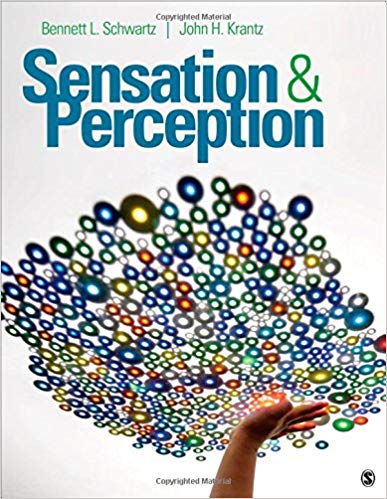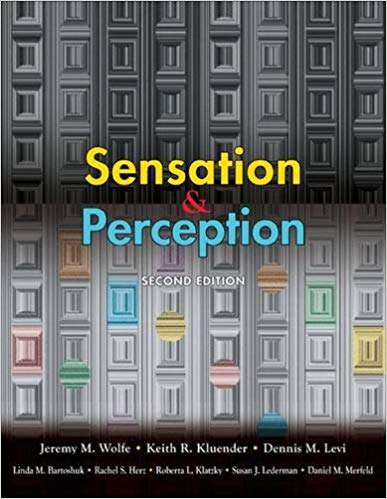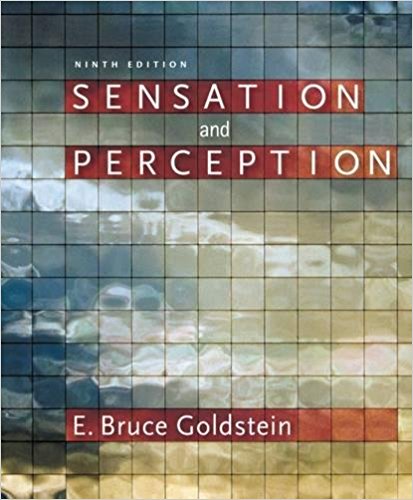Sensation And Perception 1st Edition By Bennett L. Schwartz – Test Bank
Test Bank – Chapter 5
1. Patient YM has accurate color perception, his shape perception is accurate, but he cannot determine an object’s function simply by examining it visually. Once he touches the object, he knows what it is. Your diagnosis?
a. Topographic agnosia
b. Prosopagnosia
*c. Object agnosia
d. Anosognosia
Learning objective number (if applicable): 5.1
Cognitive domain: Application
Answer location: Introduction (111)
Question type: MC
2. Our ability to detect objects must overcome three aspects of the environment: They are
a. Variable views
b. Object clutter
c. Image clutter
*d. All of the above
Learning objective number (if applicable): 5.1
Cognitive domain: Knowledge
Answer location: Introduction to Object Perception
Question type: MC
3. Top-down processing is:
a. A process whereby physical stimuli influence how we perceive them
*b. A process whereby our existing knowledge of objects influences how we perceive them
c. A process in which the top of objects is more salient than the bottom of objects
d. Processing that occurs first in the higher cortical areas and then is sent directly to the sensory organs
Learning objective number (if applicable): 5.1
Cognitive domain: Knowledge
Answer location: Top-down and Bottom-up Processing (114)
Question type: MC
4. Bottom-up processing is:
*a. A process whereby physical stimuli influence how we perceive them
b. A process whereby our existing knowledge of objects influences how we perceive them
c. A process in which the bottom of objects is more salient than the top of objects
d. Processing that occurs first in the higher cortical areas and then is sent directly to the sensory organs
Learning objective number (if applicable): 5.2
Cognitive domain: Knowledge
Answer location: Top-down and Bottom-up Processing (114)
Question type: MC
5. The storage and/or reconstruction of information in memory when that information is not in use is known as:
a. Recognition
b. Perceptual organization
*c. Representation
d. The perception-memory feedback loop
Learning objective number (if applicable): 5.2
Cognitive domain: Knowledge
Answer location: Recognition and Representation (115)
Question type: MC
6. The process by which multiple objects in the environment are grouped, allowing us to identify multiple objects in complex scenes, is known as:
a. Advanced grouping
b. Bottom-up processing
*c. Perceptual organization
d. Environmental-perceptual matrix
Learning objective number (if applicable): 5.2
Cognitive domain: Knowledge
Answer location: Perceptual Organization (115)
Question type: MC
7. Figure-ground organization is:
a. The process by which figures become ground and ground becomes figure
*b. The experience viewers have as to which part of the image is in front and which part of an image is in the background of a particular scene
c. The organization of objects into discrete groups that are grounded in reality
d. None of the above
Learning objective number (if applicable): 5.3
Cognitive domain: Knowledge
Answer location: Figure-ground Organization (117)
Question type: MC
8. In figure-ground organization:
a. The bottom of a scene tends to be seen as a figure and the top as a background
b. A figure with symmetrical borders is more likely to be judged as being in the foreground than in the background
c. The figure is more likely to be perceived as being in the foreground if it is perceived to be on the convex side of a border
*d. All of the above are true.
Learning objective number (if applicable): 5.3
Cognitive domain: Comprehension
Answer location: Figure-Ground Organization (117)
Question type: MC








Reviews
There are no reviews yet.